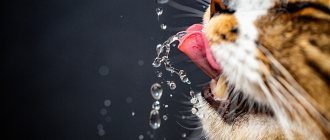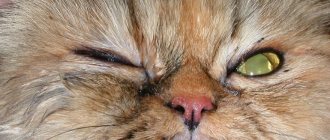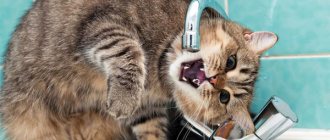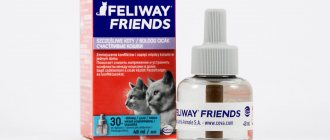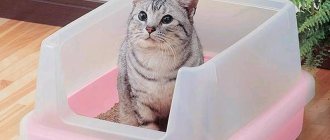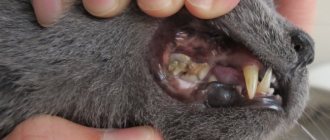In the first days of life, most cats stay hydrated from their mother's milk. But when they transition to solid food during weaning, a couple of kittens don't seem to like drinking water. Needless to say, if your furball refuses to drink water, it's only a matter of time before your pet begins to suffer from dehydration. Since dehydrated cats often experience a variety of health problems, it is important that cat parents know how to get their kitten to drink water every day.
So you want your furry friend to drink more water? If so, then you have come to the right place. Read the following information carefully to understand why cats are not interested in water and how to train your kitten to drink.
What water to give a kitten
The smell and taste of water seem incomprehensible and strange to the kitten, because they do not resemble mother’s milk.
A small cat does not need to explain the need for moisture for the body, so teaching it to lap from a bowl is not difficult
This causes difficulty in bowl training small cats. But moisture plays an important role in the growth of the pet’s body, so you need to be careful when choosing it. A high-quality drink will help the kitten quickly get used to lapping from dishes.
Attention! Boiled water is not healthy for animals.
Tap water may contain chlorine, which can repel and harm animals. Boiling will not help get rid of harmful compounds; it will increase their concentration. Due to poor quality liquid, a small cat will not be able to get mineral elements. Your pet will be at risk of developing urolithiasis.
Bottled or filtered tap water contains the necessary elements to support metabolic processes . It is already ready for consumption and does not need to be cleaned.
When is this the norm?
Experienced cat owners know the daily requirement of a pet's body for clean water. On average, the daily volume of fluid consumed is calculated individually and is about 60 ml per 1 kg of the cat’s live weight. If we judge the dry matter - 2 ml of liquid per 1 g of dry part. It is worth noting that not all cats need to drink a strictly regulated amount of liquid. After all, it is necessary to take into account a number of factors that influence not only the loss of fluid, but also the need to replenish it. The main factors are:
- cat nutrition - wet or dry granulated food; the animal eats, drinks milk or soups;
- climate and weather conditions - summer time (heat outside), cold time (dry indoor air);
- age characteristics and breed - increased activity of the pet or, on the contrary, apathy by nature.
At the same time, we must not forget that any domestic cat, even if it does not show much interest in water, should have its own drinking bowl. The water must be changed regularly and ensure that it does not have any foreign odors or impurities in its composition.
Some pet owners give their pets distilled water, believing that it is better purified. Distilled water does not contain microelements and long-term consumption of such liquid provokes disturbances in various body systems. The bowl from which your pet drinks water must be clean, preferably made of ceramic or glass. It is not recommended to use plastic containers.
How to teach a kitten to drink water from a bowl or jar
Many owners don’t know how to teach a kitten to drink water from a bowl; they try to poke it with its muzzle into the container , but this scares the pet. Use tall, dark dishes that won't confuse your cat with bright colors.
Bottled or filtered tap water contains the necessary elements to support metabolic processes
Try to entice them with a game: sprinkle a few drops with your fingers or a spray bottle. The kitten will become interested in splashing water, water circles in a bowl, and out of curiosity wets its paw into the container.
Be sure to read:
How to discourage cats from being tagged: what to do, folk and special remedies
This may frighten him, but try to reassure your baby that the liquid in the bowl is safe. Repeat the above methods, then he will get used to the bowl.
Attention! If the kitten is vomiting severely, you will have to force liquid into it using a syringe to prevent dehydration.
Another option will also help accustom your cat to the bowl: use catnip. Place the container on a cloth soaked in the liquid extract, and the cat will not remain indifferent to its smell. Try not to overdo it with mint: animals' sense of smell is much more subtle than human perception of odors.
The easiest way is to arrange dishes of different shapes and observe which bowl the kitten pays more attention to. Most importantly, don't stand next to him and don't force him to drink. Your presence can distract the cat or frighten it.
Important! Often cats drink water from the shower or sink because they are interested in it.
Interesting Facts
The origin of the cat is associated with its African history. It was in Egypt that these animals were revered most of all, they were looked after, kept clean, tidy, and extolled. A weakened craving for water and a feeling of thirst are associated with the remaining need for a small amount of water on a dry continent. But we know how important it is for a cat to drink. Therefore, you need to replace your water balance through drinking or eating.
Every owner wants their cat to be healthy. Satisfying the daily need for water (1.5-2 times more than food intake, especially if it is dry food) helps normalize metabolic processes, prevent stagnation and possible infections of the genitourinary system. Cats love to drink water from fountains, so if your pet actively asks for water from the tap, you can buy such a device for him.
Sometimes cats drink liquids from non-standard containers, such as a bucket, sink or mug. If you have the opportunity to give your pet such a drinking item, fill it with more water and place it in an accessible place. In summer, you can take a wide bowl and leave it on the balcony.
Why does a kitten not drink water well?
A kitten's refusal to drink may indicate that its teeth are changing. This occurs when the animal reaches 3-5 months. The kitten tries not to touch the loose tooth, so it is difficult for him to lap up liquids. Severe pain can cause your pet to eat less of any food. It is better to teach a kitten to drink water before the age of 3 months.
When kittens begin teething, they experience severe itching in their gums and chew on objects. If something gets stuck in a cat's throat, he will not be able to swallow normally and will refuse to drink. Try not to leave small objects on the floor - kittens will definitely try them.
Attention! Wet food already contains a certain amount of water, so the kitten may drink less if it eats spiders.
First aid
Most deaths from alcohol poisoning are associated with delayed medical care. If you suspect severe intoxication, you should urgently call a doctor.
Before his arrival:
- do not leave the person alone, even if he has fallen asleep or lost consciousness. If he starts to feel sick, he may choke on the vomit;
- It is better if the patient stays awake; you should not let him fall asleep;
- if he is vomiting but cannot get up, place him on his side to prevent him from choking;
- if there are no problems with swallowing, you can give a sorbent. This will reduce the absorption of alcohol from the stomach.
What not to do:
- give a person to drink alcohol, coffee, milk, etc.;
- send him under a cold or contrast shower or into the bath;
- try to induce vomiting, rinse the stomach (danger of internal bleeding);
- force him to walk, stand on his feet (it’s better to sit him down or lay him down comfortably).
In cases of alcohol poisoning, people most often die due to breathing problems. It is associated with the accumulation of vomit in the oral cavity and trachea. If a person is not breathing, is wheezing, or wheezing, the upper respiratory tract needs to be cleared. To do this, place him on his side, and remove the vomit with his fingers without pushing it deeper. If the victim is unconscious, he should lie so that the tongue does not fall into the larynx.
What kind of water is best to give to a cat?
Tap water is the simplest and most harmless option. But it must be cleaned before being consumed. Many owners of aqua filters forget that the device needs to be constantly changed.
Be sure to read:
A cat shits anywhere: reasons and what to do
Tap water is the simplest and most harmless option.
Filters wear out and stop doing their job. To clean the liquid from harmful substances, you can leave it in a tightly closed container for 6-8 hours. Running water contains a lot of oxygen; it attracts pets more than bottled or boiled water. This is why many cats love to climb into aquariums: they are always equipped with devices that saturate the water with oxygen.
Drinking fountains are an expensive pleasure, but this device is the most convenient and better purifies the liquid from harmful impurities. The liquid in such devices constantly circulates, enriched with oxygen and cleansed of harmful impurities. Some drinkers have a dome with a hole at the top.
It will be convenient for your pet to lick the dripping liquid. Veterinarians say that using a drinking fountain can quickly teach a cat to drink water.
Many owners, trying to please their pet, aggravate its condition. Boiling rids the liquid of parasites and the smell of chlorine. But when it evaporates, the concentration of salts increases. The resulting sediment mixes with the water and makes it “heavy.” Such drinking will not benefit the animal.
If you are concerned about the health of your family and pets, it is easier to buy bottled water. It's more expensive than pouring it from the tap. But bottled water reaches customers completely purified from harmful substances and parasites.
By looking at reviews, you can be convinced of the quality of a product of a particular brand. You cannot always be sure that the filters are working properly; they need to be constantly changed. Buying bottled water can be even more cost-effective than constantly changing purification devices.
How to recognize acute alcohol poisoning?
Any, even mild intoxication is a set of symptoms of intoxication. A person begins to experience noise in the ears, vision and hearing are distorted, speech becomes confused, and thinking becomes difficult. Alcohol may cause nausea, shortness of breath, and problems with coordination of movements. All these manifestations are dangerous, but not critical. They are not life threatening.
Acute ethanol poisoning occurs differently:
- consciousness becomes cloudy, becomes confused: there is no orientation in time, the person does not understand where he is, cannot answer questions;
- vomiting - profuse, prolonged;
- the appearance of seizures, trembling of the arms or legs, and other neurological symptoms;
- the skin noticeably pales, becomes bluish, lips may turn blue;
- breathing - irregular or rare (the intervals between breaths are not equal, longer than 7-10 seconds);
- body temperature decreases (falls below 36.2°C).
Important: loss of consciousness, sudden falling asleep, in which the victim cannot be awakened, are dangerous in combination with symptoms of both mild intoxication and acute intoxication. You can’t wait for a person to “sleep it off”; it’s dangerous with death. You need to urgently call an ambulance.
Order alcoholism coding
Experienced doctors and narcologists. In hospital or at home. 24-hour service in Moscow and the region. Professional, anonymous, safe.
With a high concentration of ethanol in the blood, an alcoholic coma can develop:
- superficial - a person loses consciousness, does not respond to speech, but pupillary reflexes are partially preserved, muscle tone changes (becomes low or high);
- deep: the patient is unconscious, the pupils do not react to light, body temperature drops sharply, muscles relax, pain sensitivity is lost.
After recovery from a coma or relief of acute symptoms, complications may develop:
- visual and auditory hallucinations, psychomotor agitation;
- increased convulsive syndrome;
- alcoholic delirium;
- complete or partial loss of vision (temporary);
- disorders of the respiratory system.
If there is a risk of complications after detoxification, the patient is left in the hospital to monitor his condition.
If there is a possibility of poisoning not only with ethanol, but also with other forms of alcohol, the victim needs emergency medical care, even if the symptoms are still mild. It can build up quickly. Methanol, ethylene glycol, and isopropyl alcohol, which are contained in technical fluids, lotions, household chemicals, etc., are especially dangerous. They can cause respiratory arrest, loss of vision, decreased blood pressure, vomiting (including blood), and coma.
Order alcoholism treatment
We work around the clock, experienced doctors, 100% anonymous.
How to determine if your cat drinks enough fluid per day
Animals have the same problems as humans when they don't get enough fluids. Cats may not get the moisture they need for a variety of reasons, but owners should closely monitor their pet's health.
Be sure to read:
What to do if a cat marks in the apartment, how to deal with it
The following signs may indicate your pet's condition:
- Skin elasticity . Your pet's skin becomes dry and stiff if he doesn't drink enough fluids. Normal dermis quickly regains its shape if you grab the cat's scruff and pull.
- Condition of the coat. It is worth sounding the alarm when the cat’s fur loses its shine and begins to fall out. If the animal does not have parasites or allergies to the selected diet, then the problem may lie precisely in the lack of moisture. When a pet's coat is shiny, it makes it clear that its health is not in danger.
- Physical activity. Without the necessary moisture, the cat becomes inactive, reacts sluggishly to calls, and does not want to play.
- Frequency of urination . If an animal urinates less than 2 times a day, this is a sign of ill health.
Symptoms of dehydration in cats
If your cat eats dry food and does not drink, we advise not to wait for signs of dehydration and contact your veterinarian immediately. However, it is worth being aware of the symptoms of dehydration. Here are the main ones:
- Frequent breathing.
- High and weak pulse.
- Salivation.
- Shiver.
- Urinating too often or too infrequently.
You can also determine whether a cat is dehydrated in the following way. Gently lift the skin from the back of your neck. If she quickly returns to her place, then everything is fine. If the skin slides down slowly or remains in place, your pet needs water.
Up
The kid is on strike
What to do if a fully grown kitten does not want to eat from a bowl? Most often this happens if the kitten is outdoors and is not used to eating in a “civilized” manner. We'll have to work. Feed your baby strictly on a schedule, do not feed him treats and do not forget food on the table. Street kittens are used to getting food on their own, but gradually the little savage will get used to the new order of things.
If a domestic kitten refuses to use the dishes, then perhaps the bowl is dirty or not very convenient. For example, standing too high, low or close to the tray. Healthy kittens learn feeding rules well and willingly eat and drink from their own dishes. The main thing is to choose high-quality and age-appropriate food for them, a comfortable bowl that is easy to clean and, just in case, be patient.
Should you force your pet to drink?
The need for forced drinking depends on the reason for refusing to drink and general well-being. In the absence of pathologies, such pressure has the opposite effect. It is much better to try the recommendations described above.
If your pet recovers from anesthesia, then he will have to be fed from a syringe without a needle for about a day. Otherwise, there is a risk of dehydration. The same applies to the listed disorders, with the exception of rabies.
